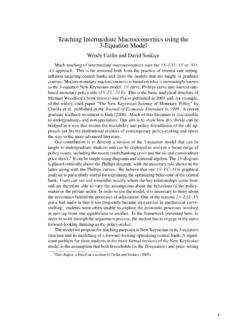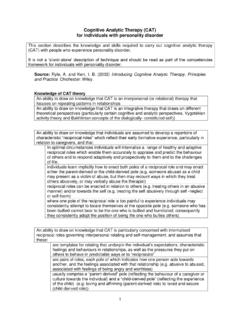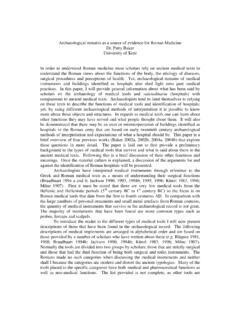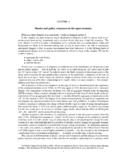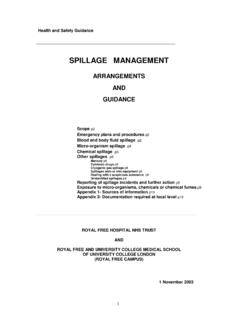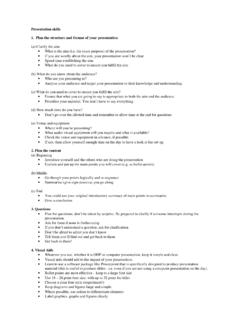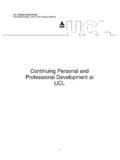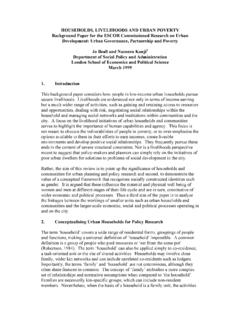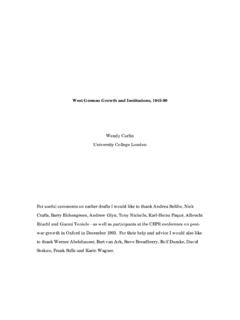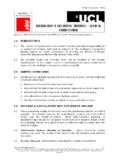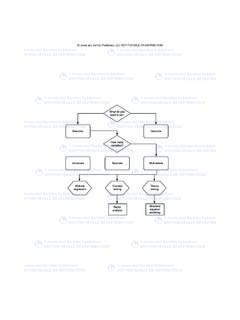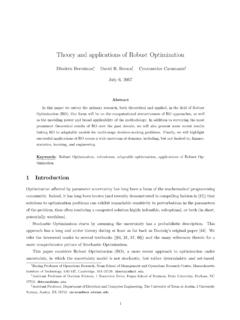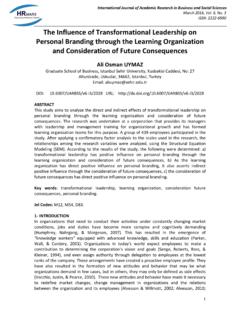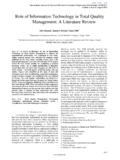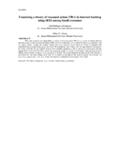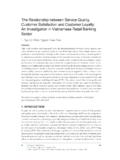Transcription of Alternative Approaches to Evaluation in Empirical ...
1 Blundell and Costa-Dias 1 Alternative Approaches to Evaluation in Empirical microeconomics Richard Blundell Monica Costa Dias& Abstract This paper reviews a range of the most popular policy Evaluation methods in Empirical microeconomics : social experiments, natural experiments, matching methods, instrumental variables, discontinuity design and control functions. It discusses the identification of both the traditionally used average parameters and more complex distributional parameters. In each case, the necessary assumptions and the data requirements are considered. The adequacy of each approach is discussed drawing on the Empirical evidence from the education and labor market policy Evaluation literature. We also develop an education Evaluation model which we use to carry through the discussion of each Alternative approach.
2 A full set of STATA datasets are provided free online which contain Monte-Carlo replications of the various specifications of the education Evaluation model. There are also a full set of STATA .do files for each of the estimation Approaches described in the paper. The .do-files can be used together with the datasets to reproduce all the results in the paper. University College London and Institute for Fiscal Studies Address: Institute for Fiscal Studies, 7 Ridgemount Street, London WC1E 7AE. ~uctp39a/. & Universidade do Porto and Institute for Fiscal Studies Address: Institute for Fiscal Studies, 7 Ridgemount Street, London WC1E 7AE. Acknowledgements: We would like to thank the editor and referees as well as graduate students and researchers at UCL, IFS and the COST A23 meeting in Paris 2008 for their helpful comments.
3 This research is part of the program of work at the ESRC Centre for the Microeconomic Analysis of Public Policy at the Institute for Fiscal Studies. We would like to thank the ESRC for financial support. The usual disclaimer applies. The data used in this article can be obtained from Costa Dias, Institute for Fiscal Studies, 7 Ridgemount Street, London WC1E 7AE, Blundell and Costa-Dias 2 I. Introduction The aim of this paper is to examine Alternative Evaluation methods in microeconomic policy analysis and to lay out the assumptions on which they rest within a common framework. The focus is on application to the Evaluation of policy interventions associated with welfare programs, training programs, wage subsidy programs and tax-credit programs. At the heart of this kind of policy Evaluation is a missing data problem.
4 An individual may either be subject to the intervention or may not, but no one individual can be in both states simultaneously. Indeed, there would be no Evaluation problem of the type discussed here if we could observe the counterfactual outcome for those in the program had they not participated. Constructing this counterfactual in a convincing way is a key ingredient of any serious Evaluation method. The choice of Evaluation method will depend on three broad concerns: the nature of the question to be answered; the type and quality of data available; and the mechanism by which individuals are allocated to the program or receive the policy. The last of these is typically labeled the assignment rule and will be a key component in the analysis we present. In a perfectly designed social experiment, assignment is random.
5 In a structural microeconomic model, assignment is assumed to obey some rules from economic theory. Alternative methods exploit different assumptions concerning assignment and differ according to the type of assumption made. Unless there is a convincing case for the reliability of the assignment mechanism being used, the results of the Evaluation are unlikely to convince the thoughtful skeptic. Just as an experiment needs to be carefully designed, a structural economic model needs to be carefully argued. In this review we consider six distinct, but related, Approaches : (i) social experiment methods, (ii) natural experiment methods, (iii) discontinuity design methods, (iv) matching Blundell and Costa-Dias 3 methods, (v) instrumental variable methods and (vi) control function methods. The first of these Approaches is closest to the theory free method of a clinical trial, relying on the availability of a randomized assignment rule.
6 The control function approach is closest to the structural econometric approach, directly modeling the assignment rule in order to fully control for selection in observational The other methods can be thought of lying somewhere in between often attempting to mimic the randomized assignment of the experimental setting but doing so with non-experimental data. Natural experiments exploit randomization to programs created through some naturally occurring event external to the researcher. Discontinuity design methods exploit natural discontinuities in the rules used to assign individuals to treatment. Matching attempts to reproduce the treatment group among the non-treated, this way re-establishing the experimental conditions in a non-experimental setting, but relies on observable variables to account for selection.
7 The instrumental variable approach is a step closer to the structural method, relying on exclusion restrictions to achieve identification. Exactly what parameters of interest, if any, can be recovered by each method will typically relate to the specific environment in which the policy or program is being conducted. In many ways the social experiment method is the most convincing method of Evaluation since it directly constructs a control (or comparison) group which is a randomized subset of the eligible population. The advantages of experimental data are discussed in papers by Bassi (1983,1984) and Hausman and Wise (1985) and were based on earlier statistical experimental developments (see Cockrane and Rubin 1973; Fisher 1951). Although a properly designed social experiment can overcome the missing data problem, in economic evaluations it is frequently difficult to ensure that the experimental conditions have been met.
8 Since programs are typically voluntary, those individuals randomized in may decide not to participate in the treatment. The measured program impact will therefore recover an Blundell and Costa-Dias 4 intention to treat parameter, rather than the actual treatment effect. Further, unlike in many clinical trials, it is not possible to offer the control group a placebo in economic policy evaluations. Consequently individuals who enter a program and then are randomized out may suffer a disappointment effect and alter their behavior. Nonetheless, well designed experiments have much to offer in enhancing our knowledge of the possible impact of policy reforms. Indeed, a comparison of results from non-experimental data can help assess appropriate methods where experimental data is not available. For example, the important studies by LaLonde (1986), Heckman, Ichimura and Todd (1998), Heckman et al.
9 (1998), Heckman, Smith and Clements (1997) use experimental data to assess the reliability of comparison groups used in the Evaluation of training programs. An example of a well conducted social experiment is the Canadian Self Sufficiency Project (SSP) which was designed to measure the earnings and employment responses of single mothers on welfare to a time-limited earned income tax credit program. This study has produced invaluable evidence on the effectiveness of financial incentives in inducing welfare recipients into work (see Card and Robbins 1998). The natural experiment approach attempts to find a naturally occurring comparison group that can mimic the properties of the control group in the properly designed experiment. This method is also often labeled difference-in-differences since it is usually implemented by comparing the difference in average behavior before and after the reform for the eligible group with the before and after contrast for a comparison group.
10 This approach can be a powerful tool in measuring the average effect of the treatment on the treated. It does this by removing unobservable individual effects and common macro effects by relying on two critically important identifying assumptions of (i) common time effects across groups, and (ii) no systematic composition changes within each group. The Evaluation of the New Deal for the Young Unemployed in the UK is a good example of a policy design suited to this Blundell and Costa-Dias 5 approach. It was an initiative to provide work incentives to unemployed individuals aged 18 to 24. The program is mandatory and was rolled out in selected pilot areas prior to the national roll out. The Blundell et al. (2004) study investigates the impact of this program by using similar 18-24 years old in non-pilot areas as a comparison group.
